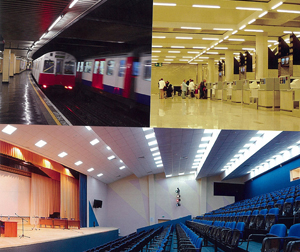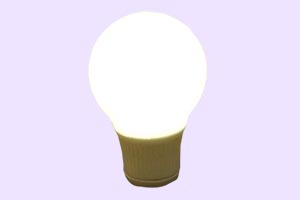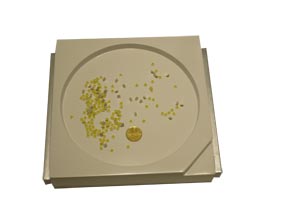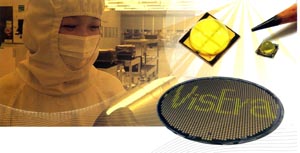Taiwanese Makers Exhibit Smart Lighting Technologies at the 2011 Hong Kong International Lighting Fair
Industry leaders tout LED lighting innovations
2012/03/08 | ByTaiwan's prominent lighting manufacturers promoted their new brand names and smart technologies at the 2011 Hong Kong International Lighting Fair (Autumn Edition) in late October. This was a significant change from their past emphasis on manufacturing capability.

One such company was Bright International Group Ltd., a lighting company founded in Taiwan in 1983 and now listed in Hong Kong. It began promoting its "LED's Pro" brand at the lighting fair last October to boost its recognition in the LED lighting industry.
According to company chairman Keen Hsu, Bright International has introduced over 500 models of LED commercial lighting with power specifications ranging from low to high power rates.
The company has manufactured a recessed light collection for diffuser lenses that can be changed to deliver the desired light pattern and color tone at commercial sites in different seasons. "This design allows business owners to spend considerably less in light collection models because they can obtain all of the properties in the whole collection simply by changing the lens," he said. According to Hsu, the thoughtful design has made these recessed lights unexpectedly popular in the United States and Japan.
A group of high-bay lights can be fine-tuned through finding the proper projection angle. Hsu said that high-bay lights are usually heavy and bulky, which makes it challenging to add an adjustable angle design to them. "So we decrease the size and weight of the lights and this way the design becomes a workable solution for them," he said. "But when you decrease the size thermal dissipation becomes an issue. Therefore, our high-bay lights are an optimal balance between size and thermal characteristics, and that's our recipe for success."
Although designed by an army of specialist designers with the involvement of over 100 designers overseas, these products are meant to attract buyers through lower pricing. Hsu said that the company has trimmed costs through increasing its automation capability, including adding SMD lines and clean rooms to its production equipment. According to Hsu, the company has also boosted its self-content ratio to 75%. "Our production lines can now finish on average five lighting modules per minute."
As a result of the shift in emphasis from traditional lamps to LED lamps, Bright International has undergone another transformation: it has created a new image for itself. Ever since entering into an alliance with Daiko Electric of Japan to focus on LED lighting, the company has worked hard to promote the red-black-white "LED's Pro" brand by sewing it on the company's uniforms and labeling it on products. The company has also created an English version of the corporate website at www.newbrightlighting.com, which surpasses the simplified Chinese version at www.brightlighting.net.
Compact LED Lamps
As a startup founded in 2007, Aeon Lighting Technology Inc. (ALT) has already created the basis for a solid brand name operation. It is owned by Super Micro Inc., which is headquartered in California and is a world leader in server maker technology. Super Micro Inc. is a knowledgeable source about various technologies crucial to the future of powerful computers such as thermal-dissipation methodology, which is a significant aspect of LED-module manufacturing. This LED-lighting manufacturer has also obtained over 100 global patents and industry certificates and has been awarded such major international awards as iF, M Technology, and Red Dot.
ALT displayed a series of unique LED streetlights, commercial lights, and residential lamps at the lighting fair, which included an MR11 lamp, a T8 light tube, a light bulb, and a group of streetlights.
Weighing 30 grams and measuring 3.5 centimeters in diameter, the MR11 produces 93 lumens per watt. The most important part of the LED T8 light tube is the translucent tube that eliminates the annoying effect of glare. The light bulb beams light at a wide angle of 270 degrees, which makes it an ideal replacement for incandescent bulbs. The company's LED streetlights measure up to the American Type I, Type II, Type III, Type IV, and Type V standards for LED streetlights.
In describing the MR11 lamp, ALT Chief Executive Officer (CEO) James Liang said that power supply is its most challenging aspect. "Considering that you have only a lamp housing that is less than two centimeters in diameter to accommodate the supply and you have to assure that the tight space has excellent dissipation, you must shrink the size of the supply significantly," he said. "And that is a huge challenge." Its light weight, compact size, and narrow beam angle make the lamp particularly suitable for lighting at department, arts and crafts, and jewelry stores.
In the cases where the T8 LED light tubes have been criticized for glaring light in transparent lenses or dim light in frosted lenses, the company has used a "semi-frosted" lens in the light tube, boosting light output by at least a quarter in comparison to the frosted light tube, thus solving the problem of glare. The tube is also a lightweight product, which makes it perfect for pendant lamps.
The company's wide-angle globe bulbs and candle bulbs are ideal replacements for mainstream residential lamps. And its most recent streetlights are excellent for thoroughfares, freeways, and intersections.
Branded Lamps
Everlight Electronics Co., Ltd. has a strategy for selling LED lights that is much different from its subcontracting work in LED-package manufacturing. The world's number one LED packager opened a lighting company, Everlight Solid State Lighting, in 2008 to promote its own-brand lighting fixtures. At the lighting fair, the company displayed a series of branded lighting fixtures, including a collection of desk lamps that it had the design company DEM Inc. develop for it. The company also exhibited at the fair other of its products such as "Prelude," a multi-function LED desk lamp, and its Everlight Beluga streetlights. The founder of the design company DEM Inc. is a grandson of the late ROC President Chiang Ching-kou.
The lamps designed by DEM are simple and elegant and can be used as a reading light, mood light, nightlight, and decorative light.
With white LEDs, the Prelude desk lamp can be used as a reading lamp, while with red LEDS it can be used as a grow light. However it is used, the lamp's sleek and slim look, along with its five-phase dimming control, is meant to attract urban professionals.
Following the launch of a series of LED streetlights for wide-area lighting, Everlight displayed both its narrow-area lighting streetlights and its Everlight Beluga products at the lighting fair. The streetlights offer a diversified design along with superb thermal dissipation and are available for various settings and conditions.
Everlight Electronics Co., Ltd. also promoted LED lights for residences, offices, business premises, and public work projects at the lighting fair. These products include light bulbs, recessed lights, downlights, tunnel lights, and warehouse lights. The 6W and 8W bulbs are meant to replace 40W and 60W incandescent light bulbs, respectively, and they can save 80% in electrical power in comparison to incandescent bulbs, and they promise a lifetime of 40,000 hours.
Total Solutions
Edison-Opto Corp. emphasizes its Lighting Design Manufacturing Service (LDMS) more than its LED package manufacturing to separate itself from the strong competition in pure package manufacturing where low-end manufacturers from mainland China have been gaining ground. LDMS, invented by Edison-Opto, offers a total solution to LED lighting manufacturing, including all of the necessary elements from frontend to backend, such as device, mechanical refinement, thermo management, electrical scheme, optical optimization, and final integration.
"Edison has stopped emphasizing its package manufacturing due to the fact that making one single device no longer produces high value," said Ethan Chen, the company's sales manager for the Chinese market. "If Taiwan's packagers do not establish some entry barriers in their operations, they will not be different from mainland Chinese manufacturers, and will likely have to continue slashing their prices along with their competitors. Our LDMS operation has been strengthened by a protective barrier consisting of the integrated elements of TEMO (thermo management, electrical scheme, mechanical refinement, and optical optimization)."
The primary targets of the LDMS operation have been European and American markets, which comprise 72% of Edison-Opto's total revenue. Edison-Opto Corp. has applied the operation to residential, commercial, and specialty-applications lighting. And its package manufacturing is ready for operations in mainland China where it already has a factory and a branch office.
Award Winning Design
Home Resource Industrial Co., Ltd., which has been awarded the Red Dot Design Award, manufactured a series of simple and sleek LED desk lamps that are monochromatic. According A.C. Lin, the company's designer responsible for the lamps, they were designed with the intention of integrating fashion with life.
Among these desk lamps is a collection named "Penguin," which, similar to the Antarctic seabird, is both black and white and has a smooth, round shape. The Penguin lamps are powered by chargeable batteries and are ideal for places where there are no electrical power lines.
Another of the company's group of stylish desk lamps has a simple design, an iron-pipe structure, and a mirror finish. These lamps come in black and silver, and the three-phase dimming design allows them to function as a nightlight, reading light, and work light. Equipped with red, green, and blue LEDs, some of these lamps can also be used as mood lights.
"These designs target European urban consumers between the ages of 21 and 40," Lin said.
CCFLs in the Spotlight
At the lighting fair, Aussmak Optoelectronics Corp., a leading supplier of cold cathode fluorescent lamp (CCFL) lighting fixtures in Taiwan, for the first time demonstrated lighting control systems that were built using electrical power lines at the fair. "In this case, power lines offer the advantage of eliminating the need to rewire the system," said George Hsu, Aussmak's general manager. "And as a result, it is not necessary to cover the traces left by rewiring." Hsu said that, instead of being used for a single lighting fixture, the control system is perfect for a lighting network consisting of multiple lamps.
Aussmak uses its CCFL lighting fixtures in the control systems. "The system can achieve dimming and CCFL is dimmable," Lin said. "So we never make compact fluorescent lamps, but instead we use incandescent bulbs. And the reason for this is that with the former dimming is not possible, whereas with the latter it is."
Although CCFL has been familiar to the LCD display industry as a backlight, it is a new application in the lighting industry. To make this new application familiar to the lighting industry quickly, Taiwan's CCFL lighting manufacturers have renamed the lamp "LCD light," with the intention of capitalizing on the fact that LCD is better known than CCFL. Lin said that LCD lights are less expensive than LED ones and provide better tones of color.
Public work projects have been Aussmak's major source of revenue, and its lighting products have been installed at facilities such as a parking lot at Charles de Gaulle Airport.


Wireless Lighting Controls
At the lighting fair, Lextar Electronics Corp., an LED-lighting manufacturer held by the BenQ Group, displayed wireless lighting control systems, which include Bluetooth 4.0 protocol and Android OS that make it operable on Android smartphones or tablet PCs. The control systems dim intensity effectively and change the color temperature of the lights they connect to within 50 meters in radius.
According to Lextar's engineers, the company installs Bluetooth 4.0 in the system because Bluetooth technology consumes less power than Wi-Fi. Most importantly, Bluetooth 4.0 is compatible with older Bluetooth versions and can handle more lighting fixtures in a single project than can older Bluetooth protocols.
Customers of the company's intelligent lighting systems are assigned a code to download control-applications software from the authorization section on the Lextar website.
The company's lighting fixtures available for connecting to the intelligent systems include LED light tubes, LED light bulbs, and LED flat-panel lights.
The light tubes feature lightweight, multi-contact points, and comply with CE, UL, and PSE standards. The GX16 light tube, produced for Japanese consumers, has received JEL801 certification. Lextar's light bulbs include A55 types weighing merely 65 grams and MR16, PAR30, and GU10 types. And the company's flat-panel lights come in four major sizes: 247mm x 40mm, 160mm x 100mm, 600mm x 600mm, and 1,200mm x 300mm. Also, the panel lights meet CE, UL, and PSE standards.

Luminosity Leader
At the lighting fair, LED chipmaker Epistar Inc. focused on its lighting solutions more than on its microchips. Among its lighting solutions is a series of light engines that the company claims has achieved an industry-high luminous efficacy of over 90 lumens per watt. Due to the company's unique warm-white light methodology, which bundles the company's blue chips with its high-voltage red chips on the same die to generate the white light, the engines produce a 2700K-3000K warm-white light at 90 CRI. According to the chipmaker, its chip arrangement achieves a maximum efficacy of 98%, which is much higher than the average 65% produced by the mixture of blue chips and yellow phosphor.
The company also displayed a light bulb with a unique lens design that allows the bulb to spread soft illumination over an angle of 300 degrees.
ProLight Opto Technology Corp., another Taiwanese LED packager, exhibited lighting solutions at the lighting fair, including light-source modules and thermal modules incorporating a secondary lens and electrical driver.
The company's light-source modules include the Phenix 3535 series, Hornet series, chip-on-board light engines, and high-voltage modules. The Phenix modules feature quality color bin and high light output and consist of a copper lead frame package and silicon lens that allow it to withstand reflow soldering heat as high as 260 degrees Celsius. And this series meets the Level 1 standard established by the Joint Electron Device Engineering Council (JEDEC) for the solid-state semiconductor industry.
ProLight Opto Technology Corp.'s COB light engines have been designed for high-power applications, and aluminum substrate makes the products highly efficient in thermal dissipation and allows optimal use. The engines are available for various lamps.
The Hornet series consists of high-power modules with warm-white, red, green, and blue LED devices, ideal for light color changing applications. The modules can achieve high light output at low watt input.
The company's high-voltage modules are available in 140 and 280 voltage types and can be used in 110V and 230V power outlets. Without boxy drivers or other massive electrical devices, the small-sized modules allow lamp makers to be very creative in their product designs.
Since LED lighting fixtures are now slim to attract consumers, size has also become an issue for LED packages.
LED Chip Packager
VisEra Technologies Co., Ltd., an IC packager held by the silicon foundry Taiwan Semiconductor Manufacturing Co. (TSMC), has applied its specialized wafer-level packaging methodology to LEDs. At the lighting fair last October, the company displayed its eight-inch aluminum nitride (AIN) wafers, thus reportedly becoming the industry's first manufacturer to package LED chips on an eight-inch AIN substrate.
The company is known for packaging its contact image sensors on eight-inch silicon wafers, and around two years ago it introduced the AIN wafer as a package substrate for LEDs.
According to B.J. Chang, senior director of the company's LED operation, , AIN is 1.4 times better than silicon wafers and outperforms aluminum oxide substrate in thermal conductivity by between seven and tenfold, at a rate of 170-230 W/mK.
At 4.6 ppm per degree Celsius, the material's thermal expansion is almost as good as silicon's, which ensures that it does not warp at high temperatures. "The wafer goes through an unorthodox manufacturing process that is completed with 1,850 C of sintering," Chang said. Also, the wafer has excellent impact resistance and is suitable for high-power LED packaging, with each wafer capable of carrying 654 four-chip packages.
In developing the wafer, which is as smooth as a mirror, VisEra worked with the military-run Chungshan Institute of Science and Technology.
One of the forums held at the lighting fair was on boosting food production through the use of LED grow lights. The speakers at this forum included: T.F. Huang, chief of the Material and Chemical Research Laboratories of the Taiwanese government-backed Industrial Technology Research Institute; S.C. Shi, chief of the Professional Lighting Department of Everlight Electronics Co., Ltd.; and H.K. Chen, project director of Epistar's Product Management Division.
In referring to the outcome of a field test of LED grow lights that he directed, Huang said that the lights increased the output of water bamboos by 10% during the winter and eliminated the problem of stunt in the produce that had occurred especially in wintertime.
Shi and Chen said that red and blue light wavelengths from LED lights are exactly the elements needed in the photosynthesis of green vegetation. They also said that famers could cultivate eco-friendly produce through making use of the wavelengths and fertilizers on different vegetables.




